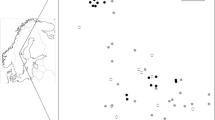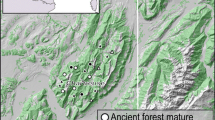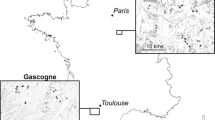Abstract
The most appropriate strategy for preserving fragmented populations depends on a species’ ability to colonise distant habitat patches. Insects associated with early decay stages of dead wood are expected to have a high capacity to colonise new habitat patches. To study the dispersal ranges of beetles (Coleoptera) and flat bugs (Hemiptera: Aradidae) dependent on recently dead aspen (Populus tremula) wood in Finland, we set out 58 piles of recently cut aspen logs at various distances up to 1.6 km from forests that contained a high density of old aspen trees. We captured insects by trunk window-traps, and counted beetles’ exit holes. Habitat connectivity was measured in terms of the amount of suitable aspen-wood in the surrounding environment, with the closest dead wood items up-weighted by a negative-exponential function. The log-piles attracted many saproxylic insects including four red-listed aspen-specialist species. The exposure of log-piles to the sun, and high levels of habitat connectivity increased the species richness of aspen-specialists, whereas bark peeling by moose decreased richness. The spatial scale at which species richness had its strongest response to habitat was 93 m. Among individual species there was a wide variability in spatial scale of response. This study supports the view that conservation efforts in boreal forests should be concentrated on sites where colonisation by target species is most likely. Restoration of habitat by re-locating logs may be useful at localities with a rich and specialised fauna but which have too low rate of formation of dead wood by natural processes.






Similar content being viewed by others
References
Berg Å, Ehnström B, Gustafsson L, Hallingbäck T, Jonsell M, Weslien J (1995) Threat levels and threats to red-listed species in Swedish forests. Conserv Biol 9:1629–1633
Edenius L, Ericsson G (2007) Aspen demographics in relation to spatial context and ungulate browsing: implications for conservation and forest management. Biol Conserv 135:293–301
Ehnström B, Axelsson R (2002) Insektsgnag i bark och ved. Swedish Species Information Centre, Uppsala
Eriksson H (1973) Volymfunktioner för stående träd av ask, asp, klibbal och contorta-tall. Rapporter och uppsatser 26. Institutionen för skogsproduktion, Skogshögskolan, Stockholm
Forsse E, Solbreck C (1985) Migration in the bark beetle Ips typographus L.: duration, timing and height of flights. Z Angew Entomol 100:47–57
Franc N, Götmark F, Økland B, Nordén B, Paltto H (2007) Factors and scales potentially important for saproxylic beetles in temperate mixed oak forest. Biol Conserv 135:86–98
Gibb H, Hjältén J, Ball JP, Atlegrim O, Pettersson RB, Hilszczański J, Johansson T, Danell K (2006) Effects of landscape composition and substrate availability on saproxylic beetles in boreal forests: a study using experimental logs for monitoring assemblages. Ecography 29:191–204
Gibbs M, van Dyck H (2010) Butterfly flight activity affects reproductive performance and longevity relative to landscape structure. Biol Conserv 163:341–350
Gustafsson L, Kouki J, Sverdrup-Thygeson A (2010) Tree retention as a conservation measure in clear-cut forests of northern Europe: a review of ecological consequences. Scand J For Res 25:295–308
Hammond HEJ, Langor DW, Spence JR (2004) Saproxylic beetles (Coleoptera) using Populus in boreal aspen stands of western Canada: spatiotemporal variation and conservation of assemblages. Can J For Res 34:1–19
Holland JD, Fahrig L, Cappuccino N (2005) Body size affects the spatial of habitat–beetles interactions. Oikos 110:101–108
Huxel GR, Hastings A (1999) Habitat loss, fragmentation and restoration. Restor Ecol 7:309–315
Hyvärinen E, Kouki J, Martikainen P (2006) A comparison of three trapping methods used to survey forest-dwelling Coleoptera. Eur J Entomol 103:397–407
Johnson ML, Gaines MS (1990) Evolution of dispersal: theoretical models and empirical tests using birds and mammals. Annu Rev Ecol Syst 21:449–480
Jonsell M, Nordlander G, Jonsson M (1999) Colonization patterns of insects breeding in wood-decaying fungi. J Insect Conserv 3:145–161
Jonsell M, Nittérus K, Stighäll K (2004) Saproxylic beetles in natural and man-made deciduous high stumps retained for conservation. Biol Conserv 118:163–173
Jonsson M (2003) Colonisation ability of the threatened tenebionid beetle Oplocephala haemorrhoidalis and its common relative Bolitophagus reticulatus. Ecol Entomol 28:159–167
Jonsson M, Nordlander G (2006) Insect colonisation of fruiting bodies of the wood-decaying fungus Fomitopsis pinicola at different distances from an old-growth forest. Biodivers Conserv 15:295–309
Kouki J, Arnold K, Martikainen P (2004) Long-term persistence of aspen—a key host for many threatened species—is endangered in old-growth conservation areas in Finland. J Nat Conserv 12:41–52
Lindhe A, Lindelöw Å, Åsenblad N (2005) Saproxylic beetles in standing dead wood density in relation to substrate sun-exposure and diameter. Biodivers Conserv 14:3033–3053
Martikainen P (2001) Conservation of threatened saproxylic beetles: significance of retained aspen Populus tremula on clearcut areas. Ecol Bull 49:205–218
Martikainen P, Kouki J (2003) Sampling the rarest: threatened beetles in boreal forest biodiversity inventories. Biodivers Conserv 12:1815–1831
Moilanen A, Nieminen M (2002) Simple connectivity measures in spatial ecology. Ecology 83:1131–1145
Nieto A, Alexander KNA (2010) European Red List of saproxylic beetles. Publications Office of the European Union, Luxembourg
Nilssen AC (1984) Long-range aerial dispersal of bark beetles and bark weevils (Coleoptera, Scolytidae and Curculionidae) in northern Finland. Ann Entomol Fenn 50:37–43
Nuorteva M, Nuorteva P (1968) The infestation of timber by bark beetles (Col., Scolytidae) and their enemies in different zones of the Finnish south-western archipelago. Ann Entomol Fenn 34:56–65
Palm T (1959) Die Holz- und Rindenkäfer der Süd- und Mittelschwedischen Laubbäume. Opuscula Entomologica Supplementum XVI, Lund
Prugh LR (2009) An evaluation of patch connectivity measures. Ecol Appl 19:1300–1310
Ranius T, Kindvall O (2006) Extinction risk of wood-living model species in forest landscapes as related to forest history and conservation strategy. Landsc Ecol 21:687–698
Ranius T, Johansson V, Fahrig L (2010) A comparison of patch connectivity measures using data on invertebrates in hollow oaks. Ecography 33:971–978
Rassi P, Hyvärinen E, Juslén A, Mannerkoski I (eds) (2010) The 2010 Red List of Finnish species. Ministry of the Environment and Finnish Environment Institute, Helsinki
Rotheray EL, MacGowan I, Rotheray GE, Sears J, Elliott A (2009) The conservation requirements of an endangered hoverfly, Hammerschmidtia ferruginea (Diptera, Syrphidae) in the British Isles. J Insect Conserv 13:569–574
Sahlin E (2009) Habitat requirements of saproxylic beetles on aspen. Doctoral thesis, Swedish University of Agricultural Sciences, Uppsala
Sahlin E, Ranius T (2009) Habitat availability in forests and clearcuts for saproxylic beetles with aspen. Biodivers Conserv 18:621–638
Sahlin E, Schroeder M (2010) Importance of habitat patch size for occupancy and density of aspen-associated saproxylic beetles. Biodivers Conserv 19:1325–1339
Saint-Germain M, Drapeau P (2011) Response of saprophagous wood-boring beetles (Coleoptera: Cerambycidae) to severe habitat loss due to logging in an aspen-dominated boreal landscape. Landsc Ecol 26:573–586
Saint-Germain M, Buddle CM, Drapeau P (2006) Sampling saproxylic Coleoptera: scale issues and the importance of behavior. Environ Entomol 35:478–487
Schroeder LM, Ranius T, Ekbom B, Larsson S (2006) Recruitment of saproxylic beetles in high stumps created for maintaining biodiversity in a boreal forest landscape. Can J For Res 36:2168–2178
Schroeder LM, Sahlin E, Paltto H (2011) Retention of aspen (Populus tremulae) at final cuttings—the effect of dead wood characteristics on saproxylic beetles. For Ecol Manag 262:853–862
Southwood TRE (1962) Migration of terrestrial arthropods in relation to habitat. Biol Rev 37:171–214
Sverdrup-Thygeson A, Birkemoe T (2009) What window traps can tell us: effect of placement, forest openness and beetle reproduction in retention trees. J Insect Conserv 13:183–191
Sverdrup-Thygeson A, Ims RA (2002) The effect of forest clearcutting in Norway on the community of saproxylic beetles on aspen. Biol Conserv 106:347–357
Travis JMJ, Dytham C (1999) Habitat persistence, habitat availability and the evolution of dispersal. Proc R Soc Lond B 266:723–728
Vehmas M, Kouki J, Eerikäinen K (2009) Long-term spatio-temporal dynamics and historical continuity of European aspen (Populus tremula L.) stands in the Koli National Park, eastern Finland. Forestry 82:135–148
Whitlock MC (1992) Nonequilibrium population structure in forked fungus beetles: extinction, colonization and the genetic variance among populations. Am Nat 139:952–970
Acknowledgments
Thanks to Osmo Heikkala, Markku Karttunen, Jukka Kettunen and Hanna Lindblom for help with the collection of field data; Rauli Perkiö (Metsähallitus) for providing forest landscape data; Alexandro Caruso for commenting the manuscript, and to Metsähallitus for organising the translocation of aspen logs, and for their support of the identification of trap samples as part of an EU-Life project “Restoration of boreal forests and forest covered mires”. This study was financed by The Swedish Research Council for Environment, Agricultural Sciences and Spatial Planning (Formas) through grant no. 215-2008-539 and Future Forests, a multidisciplinary research programme supported by the Foundation for Strategic Environmental Research (MISTRA), the Swedish Forestry Industry, the Swedish University of Agricultural Sciences (SLU), Umeå University, and the Forestry Research Institute of Sweden.
Author information
Authors and Affiliations
Corresponding author
Rights and permissions
About this article
Cite this article
Ranius, T., Martikainen, P. & Kouki, J. Colonisation of ephemeral forest habitats by specialised species: beetles and bugs associated with recently dead aspen wood. Biodivers Conserv 20, 2903–2915 (2011). https://doi.org/10.1007/s10531-011-0124-y
Received:
Accepted:
Published:
Issue Date:
DOI: https://doi.org/10.1007/s10531-011-0124-y




